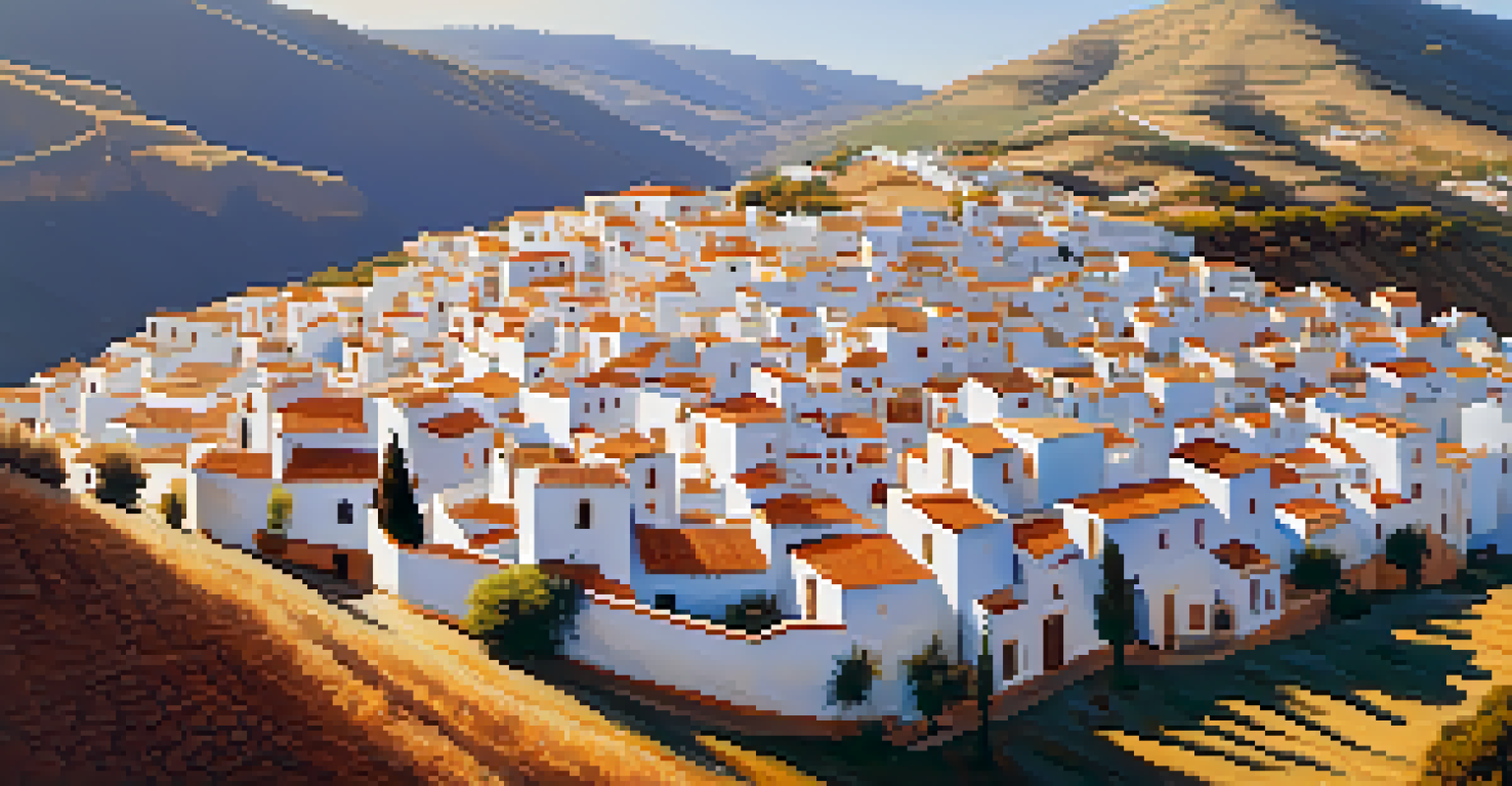Top 10 Cultural Heritage Trails in Spain: Must-Visit Sites

The Camino de Santiago: Pilgrimage of a Lifetime
The Camino de Santiago, or the Way of St. James, is perhaps the most famous cultural heritage trail in Spain. This ancient pilgrimage route leads to the shrine of the apostle Saint James in Santiago de Compostela. Travelers from all over the world seek spiritual fulfillment, stunning landscapes, and a sense of community on this 500-mile journey.
Not all those who wander are lost.
Along the way, you'll encounter charming towns, historic churches, and breathtaking landscapes that offer a window into Spain's diverse culture. From the lush hills of Galicia to the vineyards of La Rioja, every stretch of the Camino tells its own story. A variety of routes cater to different preferences, whether you prefer a leisurely walk or a more challenging trek.
As you walk, don’t forget to savor the local cuisine and immerse yourself in the region's traditions. Each stop along the way offers a taste of local specialties, inviting you to not just witness but also experience the culture of Spain firsthand.
El Camino del Cid: A Journey Through History
El Camino del Cid traces the legendary journey of the medieval hero, Rodrigo Díaz de Vivar, better known as El Cid. This trail stretches over 1,700 kilometers, leading you through the heart of Spain's historic landscapes. As you walk, you'll discover castles, fortresses, and towns that echo the tales of chivalry and valor.

The route begins in Burgos and winds its way to Valencia, passing through regions steeped in Moorish influence and Christian heritage. Each stop is rich in history, offering a glimpse into Spain's past and the conflicts that shaped it. The blend of cultures along the Camino del Cid makes it a captivating experience for history enthusiasts.
Explore Spain's Historic Pilgrimages
The Camino de Santiago and other trails offer travelers a unique opportunity to experience Spain's rich cultural heritage while enjoying beautiful landscapes.
Walking this trail not only connects you with El Cid's story but also allows you to enjoy Spain's diverse natural beauty. From rolling hills to rugged mountains, the landscapes serve as a backdrop to a journey that feels both timeless and transformative.
The Ruta de la Plata: A Roman Legacy
The Ruta de la Plata, or Silver Route, is an ancient trade route that dates back to Roman times. Spanning over 1,000 kilometers, it connects the northern and southern parts of Spain, showcasing the country’s rich history and architectural wonders. This trail is perfect for those who appreciate both history and nature.
The journey of a thousand miles begins with one step.
Along the route, you'll encounter well-preserved Roman ruins, medieval towns, and vibrant cities like Seville and Salamanca. Each stop along the Ruta de la Plata is steeped in history, providing insights into Spain's development over centuries. The trail also highlights Spain's diverse landscapes, from mountainous regions to vast plains.
Traveling this route offers an opportunity to reflect on Spain's cultural evolution while indulging in local delicacies. As you explore, you'll find that the culinary experiences are as rich and varied as the history itself, making the Ruta de la Plata a feast for both the eyes and the palate.
Pueblos Blancos: The White Towns of Andalusia
The Pueblos Blancos, or White Towns, trail takes you through some of the most picturesque villages in Andalusia. Characterized by their whitewashed buildings and stunning mountain backdrops, these towns offer a glimpse into traditional Spanish life. This route is perfect for those seeking beauty and authenticity.
As you wander through the narrow, winding streets, you'll discover local artisans, vibrant markets, and charming plazas. Each village, like Ronda and Grazalema, has its own unique character and history, reflecting the region's Moorish influence. It's an immersive experience that allows you to connect with the local culture.
Immerse in Local Culinary Traditions
Each route not only showcases stunning sights but also invites visitors to savor local dishes, enhancing the journey through Spain's diverse gastronomy.
Don’t miss out on the chance to taste authentic Andalusian cuisine, from tapas to olive oil. The culinary offerings are as inviting as the landscapes, making the Pueblos Blancos a delightful journey for both the senses and the soul.
The Via Augusta: A Roman Road Adventure
The Via Augusta is one of the oldest and most significant Roman roads in Spain, stretching from the Pyrenees to the Mediterranean coast. This historic trail offers a fascinating insight into Roman engineering and the cultural exchanges that took place along the way. Walking this route is like stepping back in time.
As you traverse the Via Augusta, you'll encounter ruins of Roman settlements, aqueducts, and ancient theaters. Each site tells a story of the people who lived and thrived in these regions centuries ago. It's a remarkable way to appreciate the ingenuity of Roman civilization and its impact on modern Spain.
Alongside the historical sites, the natural beauty of the surrounding landscapes will take your breath away. From rolling hills to coastal views, the Via Augusta is a sensory delight, making it an unforgettable journey for history lovers and nature enthusiasts alike.
The Route of the Castles: Fortresses of Spain
The Route of the Castles takes you on a captivating journey through Spain's medieval past, showcasing a landscape dotted with majestic fortresses. This trail highlights the strategic importance of these castles during the Reconquista and the rich history they embody. It's a must-visit for those fascinated by architecture and history.
Starting in the picturesque town of Almodóvar del Río, this route includes notable castles like the Alcázar of Segovia and the castle of Badajoz. Each fortress tells its own tale of battles fought and lives lived, with stunning views that make the visit worthwhile. Exploring these castles invites you to imagine the lives of those who once called them home.
Discover Architectural Marvels
From medieval castles to Moorish architecture, Spain's trails provide a glimpse into its historical significance and the intricate artistry of its past.
As you delve into the history of each castle, you’ll also discover the surrounding landscapes, which vary from rugged hills to lush valleys. This combination of history and natural beauty makes the Route of the Castles an enriching experience for all travelers.
The Wine Routes of Spain: Sip and Savor Culture
Spain is renowned for its exquisite wines, and the Wine Routes offer a delightful way to explore the country’s viticultural heritage. These trails wind through picturesque vineyards and charming wine-producing towns, each with its own unique flavors and traditions. It's a dream come true for wine enthusiasts.
As you travel along these routes, such as the Ribera del Duero or La Rioja, you’ll have the opportunity to taste exceptional wines right where they’re produced. Many wineries offer tours that provide insights into the winemaking process, allowing you to appreciate the craftsmanship behind each bottle. It's a sensory journey that celebrates the art of wine.

Moreover, the surrounding landscapes are breathtaking, dotted with rolling hills and vibrant vineyards. Pairing the scenic views with local gastronomy creates a rich cultural experience that extends beyond just wine tasting, making the Wine Routes an essential part of Spain's heritage.
The Cultural Route of the Moors: Echoes of Al-Andalus
The Cultural Route of the Moors invites you to explore the legacy of Al-Andalus, the Moorish kingdom that once flourished in Spain. This trail takes you through stunning cities like Granada, Córdoba, and Sevilla, showcasing the architectural marvels and rich traditions that emerged during this period. It's a cultural odyssey that celebrates diversity.
Walking this route allows you to witness the intricate designs of Moorish architecture, including the Alhambra and the Great Mosque of Córdoba. These historical sites are not only visually stunning but also carry deep cultural significance, representing a blend of Islamic and Spanish influences. Each site whispers stories of coexistence and cultural exchange.
The journey also offers a chance to enjoy the delicious flavors of Moorish cuisine, with dishes that reflect the region's rich history. From spices to sweets, the culinary surprises enhance your experience, making the Cultural Route of the Moors a feast for the senses and a profound exploration of Spain's multicultural past.